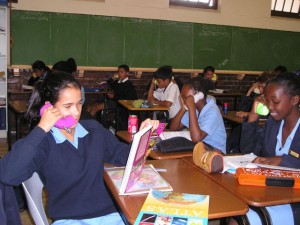Shared and Guided Reading periods
 Learners bring their Sebezaphones with them when called to sit ‘on the mat’ with the teacher.
Learners bring their Sebezaphones with them when called to sit ‘on the mat’ with the teacher.- Change “Choral Responses” to Sebezaphone responses where every child is responsible for responding for him/herself. For example, when the teacher asks all learners to respond in Chorus, such as reading words or sentences from the Big Book, have all learners whisper the response into their Sebezaphone. This ensures that all learners repeat the words, say the syllables, the sounds and spellings the teacher wants them to notice, and to read the sentences. While all learners are softly speaking into their Sebezaphones, the teacher moves around the group, listening in on what the children are saying. In this way, the teacher can monitor which of the children are actually able to read what has been assigned. Requiring learners to each speak into their own Sebezaphone focuses learners’ attention on what is to be mastered. Choral work can be ‘mindless’ because learners can more easily silently mouth the words, hide behind the group’s response and disengage from the thinking required by the task.
- Whenever the teacher poses a thoughtful question about the text, invite every learner to answer at once in their Sebezaphone (Think-Aloud). Then have the learners turn to a partner and share their thoughts (Think-Pair-Share). This can then be followed by the teacher calling upon 2-3 learners to share their thoughts with the whole class. In this way, every child has had an opportunity to formulate his/her thoughts, respond to the question, and cognitively rehearse what they are learning. Talking is critical for learning: it enables the brain to grow dendrites and form new neural pathways that is the essence of learning.
- When reading a common text in small homogeneous groups, all children can read at once and the teacher can listen in on each child’s reading and make appropriate interventions.
- Paired Reading: Teacher, parent or older learner reads with the younger reader, who reads along into the Sebezaphone. At first the stronger reader leads the reading, but on second and third readings of the same book, the younger reader takes more and more of the lead. The stronger reader reads more and more quietly as the younger reader gains confidence.
 Learners bring their Sebezaphones with them when called to sit ‘on the mat’ with the teacher.
Learners bring their Sebezaphones with them when called to sit ‘on the mat’ with the teacher.
